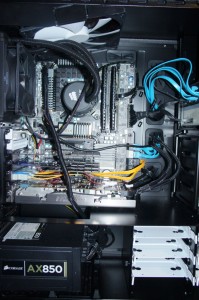TEST SYSTEM AND METHODOLOGY
 This is The SSD Review Test Bench and a quick click on the photo will bring it up full size for closer inspection.
This is The SSD Review Test Bench and a quick click on the photo will bring it up full size for closer inspection.
- Our main goal in testing is to ensure that all test results are as accurate as they can be and no anomalies slip through.
- We conduct all tests three times and, if necessary, we may conduct specific tests in Windows 7 ‘safe mode’ to ensure the OS has little to no influence on the end result.
- We prefer to use as many benchmark programs as possible to assist with confirmation of results and provide the reader with the actual tests as received to avoid any confusion when unexpected test benchmarks are received.
- .
BENCH CONFIGURATION
MOTHERBOARD: Gigabyte P67A-UD7 ATX LGA 1155 Intel SATA 6Gb/s USB 3.0
CPU: Intel Core i7-2600K Sandy Bridge 3.4GHz (3.8GHz Turbo Boost) 4 x 256KB L2 Cache 8MB L3 Cache LGA 1155 95W Quad-Core Desktop Processor
RAM: Corsair Vengeance 8GB DDR3 1600 SDRAM
GPU: MSI N560GTX-Ti Twin Frozr II OC Edition 1024MB GDDR5 PCI Express 2.0
POWER: Corsair Professional Series AX850 850W ATX12V v2.31 / EPS12V v2.92 80 PLUS GOLD Certified Modular Active PFC Power Supply
CHASSIS: Fractal-Design Define XL ATX Mid Tower Silent Computer Case
CPU COOLER: Corsair H50 High Performance Water CPU Cooler
NETWORK: DiLink Powerline AV Network With D-Link DIR 655 Wifi N Router
DVD: Sony Black 24X DVD+R 8X DVD+RW 8X DVD+R DL 24X DVD-R 6X DVD-RW 12X DVD-RAM 16X DVD-ROM 48X CD-R 32X CD-RW 48X CD-ROM 2MB Cache SATA 24X DVD Writer
STORAGE: 3 x Icy Dock 4×1 SSD Racks for 5.25″ Device Bay
BENCHMARK SOFTWARE
Software used for our testing today consists of ATTO Disk Benchmark, Crystal Disk Mark, HDTune Pro, AS SSD and PCMark Vantage. Although these programs each serve a specific function, a basic knowledge of each is necessary as they do not always provide the result expected in consumer testing which leads to a great deal of confusion. ATTO and HDTune both test through use of raw data whereas Crystal (by default) and AS SSD utilize random data in testing which results in benchmarks below manufacturers specifications when testing SSDs that use compression in their storage such as SandForce.
SandForce does not recommend testing with random data and, for this reason, we might test with Crystal in ‘0Fill mode’ to demonstrate how manufacturers reach their specifications. Another interesting point to consider is that, although Crystal Diskmark and AS SSD both conduct the same test several times, Crystal will provide the highest reached as the end score whereas AS SSD provides the average of all tests.
 We can see here that TRIM is working properly as well as NCQ. NCQ is Native Command Queuing. NCQ has the ability to speed up your SSD by internally organizing the order in which received read and write commands are executed.
We can see here that TRIM is working properly as well as NCQ. NCQ is Native Command Queuing. NCQ has the ability to speed up your SSD by internally organizing the order in which received read and write commands are executed.
Introduction ~~ Test Bench ~ ATTO & Crystal Diskmark ~~ AS SSD
 The SSD Review The Worlds Dedicated SSD Education and Review Resource |
The SSD Review The Worlds Dedicated SSD Education and Review Resource | 